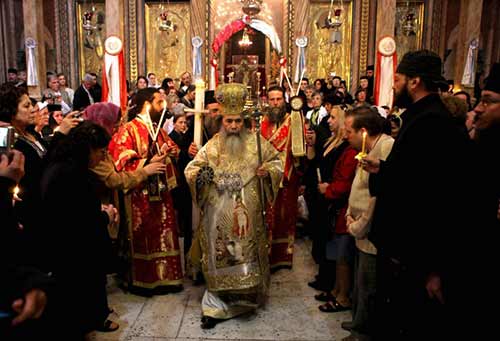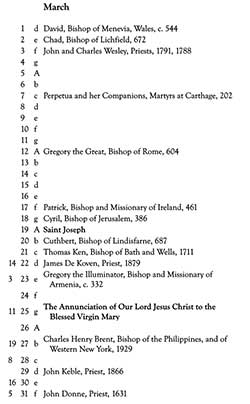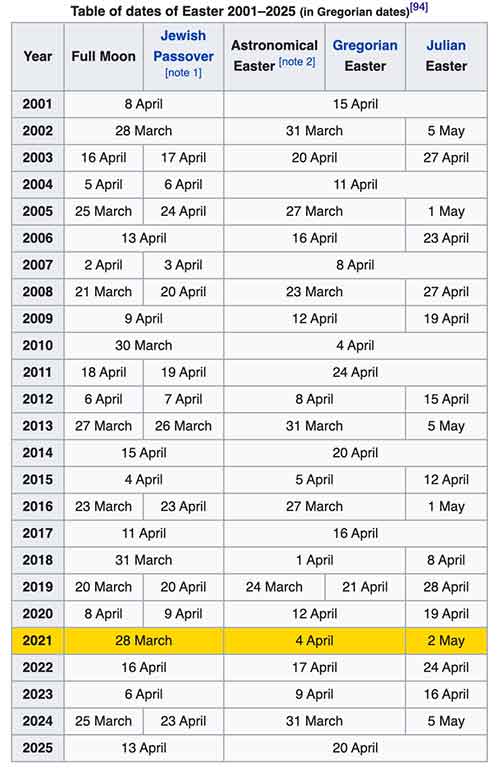
Easter keeps moving around from year to year! And wait, there’s more: for those of us in the Western tradition, today is the 12th Day of the Great 50-Days Easter Season (or Day 11 for some reading this – shock: conspiracy theories notwithstanding, the world IS round! For others, late to reading this post, I don’t know where you are in the Church Year).
For those in the Eastern tradition of Christianity, Easter Day is Sunday 2 May, 2021.
All hold to the agreement made at the Council of Nicaea (325AD) that Easter Day is:
The first Sunday after the first full moon on or after the vernal equinox.
The Eastern Orthodox Church continues to follow the Julian calendar when calculating the date of Easter. The rest of Christianity uses the Gregorian calendar (introduced in 1582 with a new leap-year rule: centurial years are only leap years if they are exactly divisible by 400). Currently, the Julian calendar is 13 days behind the Gregorian.
The Church does not use the actual date for the vernal equinox, but a fixed date (March 21), nor does it use the astronomical full moon but the “ecclesiastical moon”.
The church has a 19-year cycle (the metonic cycle – named after Meton of Athens, 5th century BCE; the Babylonians followed this 19-year cycle from the 6th Century BCE). Every 19 years, the phases of the moon (pretty accurately) recur at the same time of the year. So, divide these 19 years into 235 lunar months of 30 and 29 days each. Each of these lunar months begins with an “ecclesiastical new moon”. The 14th day of such an ecclesiastical month, hence, is the ecclesiastical full moon).
Each year has a “Golden Number”: divide the AD year by 19 and add one to the remainder. 2021 divided by 19 is 106 with a remainder of 7. Add 1 to that remainder and you have the Golden Number for this year is 8. Golden Numbers for the year have been around for a good thousand years or so. Over many centuries, the Golden Numbers appear alongside Church Calendars. The Episcopal Church’s Book of Common Prayer Calendar includes the Golden Number of the ecclesiastical full moon from March 22 to April 18:

From The Episcopal Church’s Book of Common Prayer Calendar (left), the 2021 Ecclesiastical Full Moon after 21 March was 28 March [Golden Number 8]. That day was a Sunday. It was Full Moon. So the first Sunday after that Full Moon was 4 April = Easter Day in 2021 in the West.
Christians celebrated a common date for Easter between 325 and 1582, the latter being the date of the West’s change to the Gregorian calendar. The two dates, East and West, still coincide when the full moon following the equinox comes so late that it counts as the first full moon after 21 March in the Julian calendar as well as the Gregorian. This happened in 2010, 2011, 2014, and 2017, and will next happen 2025.
To bring together the East and West’s differing Easters, the World Council of Churches proposed calculating Easter from the actual equinox and the full moon at the meridian of Jerusalem (the scene of Christ’s death and resurrection). The following table (source) shows this astronomical Easter in comparison to others (Passover commences at sunset preceding the date indicated):

I would be in favour of moving to the World Council of Churches proposal unless it risked ending up with three rather than two dates for Easter!
There is also a proposal to remove the association with the Moon (and hence links with the lunar Passover tradition) and fix the date of Easter to be conveniently the same Sunday each April. I would be saddened at such another loss of our connections with nature. There we stand, as we have for centuries, under the full moon lighting our Easter fire; with the full moon so wonderful, before electric light, for our human celebrations. I also do not think it is likely that abandoning Nicaea’s agreement would be agreed to – so that way we would definitely result in three Easter Days.
The Ecumenical Patriarchate’s permanent delegate to the World Council of Churches, Archbishop Job Getcha, called for the celebrating of Easter on the same day from 2025 (see here; h/t Bp Peter Carrell). In that year (see the table above) East and West celebrate on the same day. 2025 is 1700 years since the Council of Nicaea – when the rule was decided. Johannes Oeldermann, from the Johann-Adam-Möhler-Institute of Ecumenism (Germany) highlighted, however, that there would be Russian Orthodox opposition if this is promoted by the the Ecumenical Patriarchate, and other Orthodox opposition if it is seen as a Roman Catholic initiative. I am not sanguine about the possibility of a single Easter Day from four years time.



Bosco, you have hit the nail on the head when you drew attention to Trinity Sunday. I have watched over the years the diminishment of the Festival, from the numbering of the following Sundays and the lack of recognition that it is the Great Festival of God. I think people are afraid of God the Father, in favour of the remain